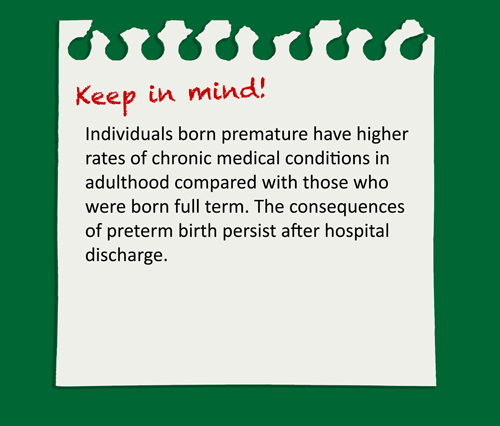Lesson 1: Preterm Birth: A Global Public Health Issue
1.3 The consequences of preterm birth
In normal fetal development, the last months and weeks of gestation are a time of growth and development. Preterm birth occurring <37 weeks of gestation, is a major public health problem. Preterm birth consequences are not limited to the individual newborn infant but to her family and to society as a whole.
In the past, a large emphasis in neonatal intensive care units was on life-saving respiratory support measures. As neonatal respiratory support has improved, growing numbers of preterm infants are surviving to childhood and adulthood. In neonatal intensive care units attention is shifting from mere survival to optimization of long-term health and quality of life for survivors of preterm birth. The rapidly growing number of adult survivors of preterm birth has made possible large epidemiologic studies on long-term outcomes. Even in developing nations, low-cost interventions requiring little technology can save many preterm infants. Here, too, as survival rates improve, attention must be turned to improving the long-term outcomes for these infants. There is increasing evidence that improved early nutritional care of preterm infants has the potential to profoundly improve their later health.
The most common consequences of preterm birth are shown in Table 2.
Table 2: Long-term impact of preterm birth on survivors
Source: WHO et al. 2012
Figure 4 below shows the inverse relationship of birthweight to prevalence of certain disabilities in preterm birth survivors.
Figure 4: Prevalence of selected disabilities vs. birthweight in a cohort of children assessed at age 3 who were born prematurely in the period 1981-1993.
Source: ENeA own graph. Data from Behrman et al. 2007
Recently, a number of studies have demonstrated that prematurity increases the risk of certain diseases and conditions later in life, such as diabetes (Tinnion et al. 2014, Hofman et al. 2004), hypothyroidism (Crump et al. 2011), high blood pressure (Sipola-Leppanen et al. 2015), even obesity (Mathai et al. 2013) and psychosocial challenges (Mannisto et al. 2015). A large Swedish cohort study has demonstrated that a low gestational age at birth was independently linked to increased mortality in early childhood and young adulthood (Crump et al. 2011a).
The long-term disabilities caused by preterm birth impact patients and their families, health and education systems, and society as a whole. The long-term psychosocial and emotional costs to the affected child and his or her family cannot be calculated. Estimating the monetary costs associated with preterm births is difficult, but even conservative estimates are high. In the first year of life an infant born at less than 28 weeks in the United States incurred medical costs of over $190,000 in 2005 compared to about $94,000 for an infant born between 28-31 weeks, $13,000 for an infant born between 32-36 weeks and $3,300 for term infants (Behrman et al. 2007). According to the Institute of Medicine,
"the annual societal economic burden associated with preterm birth in the United States was at least $26.2 billion in 2005, or $51,600 per infant born preterm.”
(Behrman et al. 2007)
Clearly, preterm birth presents a major public health issue. The most direct approach to the problem, addressed in the WHO "Global Action Report on Preterm Birth" (WHO et al. 2012), is to take measures to decrease the incidence of preterm birth through targeted prenatal care. The next step is to improve survival of infants born prematurely. And the final step, beyond survival, is improvement of the long-term health of these infants as they grow up.
Ensuring optimal nutritional care of preterm infants to allow for growth and development similar to that in utero has become an increasingly important public health priority.
The World Prematurity Day is observed every year on the 17th of November.


